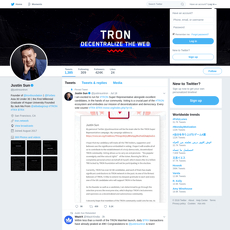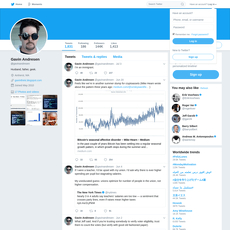Tuur Demeester Review
Tuur Demeester
twitter.com
Tuur Demeester Twitter (X) Review Guide: Is He Worth Following?
Feeling lost scrolling through crypto takes that contradict each other every hour? Wondering if following Tuur Demeester on X/Twitter is actually worth your time?
If you want less noise and more signal from a seasoned macro Bitcoiner, you’re in the right place. I’ll show you exactly what you’ll get from Tuur’s feed, who it’s for, what to watch out for, and how to turn his insights into smarter decisions.
Describe problems or pain
Crypto timelines are a mess. Hype cycles move faster than attention spans, and the loudest voices often drown out the most useful ones. It’s not just annoying—it’s expensive if confusion pushes you into bad decisions.
- Contradictory calls: One post says “cycle top,” the next screams “new paradigm.” Which one do you trust?
- Volume over value: High-frequency feeds flood you with micro-updates that rarely change your plan.
- No macro map: Without context on liquidity, policy, and credit cycles, Bitcoin moves feel random.
- Time sink: You can waste hours chasing threads that don’t improve your edge.
Finding signal in crypto often feels like panning for gold in a river of noise. You need a consistent filter, not endless scrolling.
There’s a reason this happens. Research from MIT on information spread found false or sensational news travels faster than the truth on social platforms. That dynamic shows up in crypto every day, especially around big moves and policy headlines. If you don’t curate your inputs, the feed will curate your thinking—for the worse.
Promise solution
Here’s my promise: I’ll break down what makes Tuur’s Twitter feed useful (and where it isn’t), so you can get to clarity fast. We’ll map his background, the way he frames cycles, how he thinks about Bitcoin, and a simple workflow for turning his posts into actionable context—without falling into an echo chamber.
Expect practical takeaways. For example, when many were obsessing over minute-by-minute price action in late 2022, Tuur highlighted big-picture credit tightening and historical drawdown context—exactly the kind of framing that keeps you from panic-selling bottoms or chasing tops.
Who this guide is for
- Bitcoin-focused investors: You care about cycles, scarcity, and adoption curves—not memecoins.
- Macro-curious traders: You want to understand how liquidity, rates, and policy shape BTC trends.
- Researchers and builders: You prefer long-term thinking and historical perspective over hot takes.
What you’ll learn
- What Tuur actually posts on X/Twitter—and why it tends to be high-signal
- How his macro lens can sharpen your Bitcoin framework
- A simple way to follow him efficiently without living on the timeline
- The best complementary sources to round out his perspective
- Clear answers to common questions (posting cadence, bias, how to use his insights)
So, who is Tuur Demeester, and why do so many long-term Bitcoin thinkers pay attention when he posts? Let’s look at that next.
Who is Tuur Demeester?
When I think “macro signal for Bitcoin,” I think of Tuur Demeester. He’s not a hot-take machine. He’s an independent investor and newsletter writer rooted in Austrian economics, with a habit of putting hype in its place and bringing history into every market conversation. If you want to understand how policy, credit, and human behavior collide with Bitcoin cycles, his work is a reliable compass.
“The curious task of economics is to demonstrate to men how little they really know about what they imagine they can design.”
— F.A. Hayek
That quote sums up the tone you’ll get from Tuur: humble about prediction, serious about cause and effect, and focused on incentives over narratives.
Background and credentials
I’ll keep it tight and useful—here’s why his profile stands out:
- Independent investor and writer: He publishes long-form Bitcoin research and essays, prioritizing frameworks over quick calls.
- Austrian economics lens: Expect conversation about business cycles, monetary policy, capital formation, and how credit booms/busts shape Bitcoin demand.
- Established Bitcoin research track record: Notable reports include “Bitcoin in Heavy Accumulation” (Adamant, 2019) and “How to Position for the Bitcoin Boom” (Adamant, 2023). These aren’t buzzword slides—they’re historically grounded, market-structure aware, and readable.
- Respected media footprint: His commentary has appeared across reputable crypto publications (including CoinDesk features and interviews), plus a long paper trail of talks and podcast appearances.
- Founder-level research roles: He’s built and led Bitcoin-focused research outfits (Adamant Research), emphasizing cycle analysis, mining economics, and investor education.
One thing I appreciate: when Tuur made the case in 2019 that Bitcoin was in a “heavy accumulation” phase, the thesis leaned on history and on-chain context. In hindsight, that period did precede a broad secular advance. It’s not about perfect timing—it’s about helping you hold a coherent map when the road gets foggy.
Why his voice matters in crypto
Most timelines are loud. His isn’t. That’s the point.
- Macro meets Bitcoin: He connects policy shifts (rates, liquidity, credit conditions) to Bitcoin’s longer arcs—useful for investors who plan beyond next week.
- History as a filter: Bubbles, busts, mining cycles, and regulatory swings—he constantly brings receipts from prior eras so you can avoid déjà vu mistakes.
- Low noise, high conviction: He doesn’t post every day. When he does, it’s usually a thread or chart that reframes the story without drama.
- Education over hype: Instead of “this will pump,” he’ll ask, “what are the incentives and constraints?” That mental model is worth its weight during volatility.
If you’ve ever felt torn between bullish headlines and macro uncertainty, his framing helps you step back and ask better questions, not chase hotter takes.
Quick timeline snapshot
- Early 2010s: Among the earlier public voices taking Bitcoin seriously, writing and speaking while most media dismissed it.
- 2017–2018: Through mania and drawdown, he emphasized cycle literacy and risk management over bravado.
- 2019: Published “Bitcoin in Heavy Accumulation”, arguing for a structural build-up phase following capitulation—an idea later echoed by multiple on-chain datasets as long-term holder supply climbed.
- 2020–2021: Consistent macro commentary as liquidity regimes shifted and institutions tested the waters.
- 2023–present: With “How to Position for the Bitcoin Boom”, he refreshed core strategy principles for the next leg of adoption, pairing history with practical allocation thinking.
I follow Tuur for the same reason I keep a good map app on my phone: not to tell me how fast to drive, but to show me the terrain ahead. So, what actually shows up in your feed if you hit “Follow” on Tuur Demeester on X/Twitter? Is it charts, threads, or something else—and how often? Let’s unpack that next.
What you actually get from his Twitter timeline
When I open Tuur Demeester’s X/Twitter feed, I’m not hunting for hot takes—I’m looking for clarity I can use. His timeline feels like a well-edited notebook: fewer posts, each carrying context, history, and a simple point that sticks.
“Signal beats speed. Your job is to think, not react.”
Content types you’ll see
- Analytical threads: Multi-post breakdowns connecting Bitcoin’s market structure with macro shifts—think funding conditions, liquidity, and credit cycles. These threads often include charts and historical parallels rather than price targets.
- Curated research: Links to strong primary sources—central bank releases, BIS papers, energy data, and Bitcoin research—so you don’t get stuck in second-hand narratives.
- Charts with context: He’ll share a chart (M2 growth, BTC drawdowns, hash rate, miner margins) and add one or two lines that frame it inside the bigger picture.
- Monetary history nuggets: Snapshots from gold standard changes, inflation waves, or policy pivots that rhyme with what Bitcoin is experiencing. It’s history used as a tool, not trivia.
- Mining and economics angles: Occasional takes on miner profitability, capex cycles, energy pricing, and how these feed into supply dynamics over months and years.
- Links to longform work: Every so often he’ll share essays and reports (e.g., cycle research and historical analysis) that you’ll want to save for deeper study.
Topics he focuses on
- Bitcoin cycles: Where we are in the cycle using drawdowns, realized value metrics, and past analogs. This aligns with what on-chain firms like Glassnode and Coin Metrics have documented—cycles compress, but human behavior rhymes.
- Monetary policy and liquidity: How rate paths, credit spreads, and balance sheets affect risk appetite. You’ll see him frame Bitcoin inside the same currents that move gold, credit, and USD liquidity.
- Inflation and credit dynamics: He connects inflation data, money supply shifts, and lending conditions to Bitcoin’s role as a hedge or speculative asset, depending on where we sit in the cycle.
- On-chain and mining context: Not “on-chain day trading,” but big structural signals—hash rate trends, miner stress points, and supply schedules that actually matter.
- Market psychology: Warning signs of exuberance, fear, and narrative traps. Useful during euphoria and panic, when your brain wants shortcuts.
- Regulation and policy: How jurisdictional moves and enforcement shape liquidity venues, custody, and long-term adoption.
Posting cadence and tone
He’s not flooding your feed. Expect a measured cadence—more activity around macro inflection points, then quieter spells when noise is high. The tone stays calm, sourced, and intentionally unemotional. It reads like a field journal: observations first, opinions second, trades never.
Example value moments
- Cycle turning-point commentary: During late-stage bull phases, he’ll surface reminders from prior bubbles—valuation stretches, leverage buildups, or funding premiums—and compare them to today’s setup. It nudges you to slow down when speed feels tempting.
- Reframing charts: A simple chart of BTC drawdowns across cycles, paired with context on duration and magnitude, can reset expectations in one glance. On-chain research backs this up—realized cap and supply-in-profit metrics tend to cluster near cycle lows, which matches the kind of lens he brings.
- Mining stress signals: Notes on hash rate surges or miner revenue squeezes help explain why price volatility can persist even when “on-chain looks healthy.” If you’ve followed miner capitulation studies, you’ll recognize the pattern: capex booms, profitability compresses, weaker operators exit—supply pressure abates later.
- Monetary policy framing: When liquidity turns, he’ll connect the dots: tighter conditions, slower credit, and how risk markets repriced in similar historical episodes (think post-1971 currency shifts or early 1980s inflation battle). It’s the kind of context that moves you from “headline-chasing” to “thesis-building.”
- Curated research that saves time: Instead of reading 20 articles, you get one high-signal link and a short takeaway. That curation has real ROI if you track macro and Bitcoin but don’t live on Econ Twitter.
I keep coming back because the feed respects my time. It trims the fat, surfaces the right questions, and gives me better words for what I’m seeing. When the noise gets loud, that’s not just helpful—it’s sanity-saving.
Want to know where this kind of timeline shines—and where it won’t help you at all? I’ll show you exactly how to set expectations so you don’t misread the signal in the next section.
Strengths and limitations (so you set the right expectations)
Think of his feed as a macro-Bitcoin compass. It won’t ping you trade entries, but it will keep you pointed toward signal when the market turns into a carnival. When the market screams, his posts tend to whisper—and that calm is the point.
“Patience is a position.”
Strengths
- Clear macro lens: He frames Bitcoin inside credit cycles, liquidity, and policy. That lens is incredibly useful when volatility spikes. Example: during post-halving chop and policy jitters, his threads often emphasize liquidity conditions over headline drama—exactly what most traders overlook.
- Deep Bitcoin knowledge: He’s not guessing. He’s studied mining economics, market structure, and historical adoption. His “Bitcoin Reformation”-style essays and research-minded threads show why Bitcoin tends to behave like a monetary asset first, tech stock second.
- Historical perspective: Expect references to gold-era dynamics, credit contractions, and prior crypto cycles. When sentiment swings, he’ll pull a chart or anecdote from 2013/2017/2020 that instantly re-centers expectations. Those “I’ve seen this movie” posts help you avoid panic decisions.
- Low noise, strong curation: He doesn’t post to fill a quota. Fewer tweets, more signal. Behavioral finance backs this restraint—investors who trade less tend to perform better. See Barber and Odean’s study “Trading Is Hazardous to Your Wealth,” which found higher trading frequency correlated with lower returns (SSRN), and Dalbar’s research showing the “investor behavior gap” from overreacting to noise (QAIB).
- Evidence-first track record: He’s published longform research that aged well, like the 2019 accumulation narrative that matched Bitcoin’s multi-quarter base-building before the next breakout. That kind of cautious, data-backed framing beats reactive takes.
Limitations and biases
- Bitcoin-first bias: He prioritizes Bitcoin. If you want a steady stream of altcoin deep dives, you’ll be disappointed. You’ll get macro and Bitcoin clarity—great for anchoring risk, not for sector-rotations in microcaps.
- Lower posting frequency: You won’t get minute-by-minute commentary. If you’re a scalper, the tempo will feel slow. The upside: less fear-of-missing-out chatter, more thoughtful context.
- Not a trade coach: Don’t expect “buy here, sell there.” He’ll outline why liquidity or policy shifts matter. You still need your own trigger rules, risk sizing, and invalidation levels.
- Austrian economics lens: It’s a powerful framework for money and cycles, but it can underweight narratives outside hard-money focus—like some platform/utility coin use cases. Keep that in mind if you manage a diversified crypto portfolio.
- Macro ≠ micro timing: Great macro calls can be early. If you compress them into a day-trading window, you’ll get chopped. Align his perspective with your timeframe.
Who will benefit most
- Long-term Bitcoin investors: Looking to avoid headline traps and anchor decisions in policy, liquidity, and cycle context.
- Macro-curious traders: Swing and position traders who want a north star to pair with their own entries/exits.
- Builders and allocators: Founders, miners, treasury managers, or family offices who need a principled framework more than hot takes.
- Who won’t love it: High-frequency scalpers or altcoin chasers who want rapid-fire calls and handholding.
If you’re thinking, “Okay, how do I turn that calm, macro-first signal into something I can actually use on volatile days?”—good question. In the next section, I’ll show you the simple, 10-minute workflow I use to turn one thoughtful thread into concrete decisions without overtrading. Want the checklist?
How I use Tuur’s insights in my crypto workflow
A quick workflow that works
I treat Tuur’s posts like high-signal research notes, not trade calls. The goal: capture the thesis fast, plug it into my system, and only act when my plan says so.
Signal-only alertsI tap the bell on his X account and add him to a private “Macro-Bitcoin” List in X Pro/TweetDeck. Lists reduce feed noise and let me scan his posts alongside two or three complementary voices. No doomscrolling, just signal.
Summarize the thread in 60 secondsWhen a thread lands, I write a three-line summary in my notes:
- Thesis: e.g., “Credit tightening + weak liquidity = more chop before trend resumes.”
- Bitcoin implication: “Favor accumulation over breakout-chasing.”
- Invalidation: “If credit spreads narrow for 4 consecutive weeks and DXY rolls over, bias changes.”
This “implementation intention” habit is backed by research showing it increases follow-through under stress (Gollwitzer, 1999).
Tag and fileI tag the note with simple labels like #policy, #mining, or #cycle. If he references historical cases (Volcker tightening, 1930s devaluations, past halving behavior), I link a chart and stash it in a “Playbooks” folder.
Convert to triggers, not tradesInstead of “Buy/Sell,” I create if-then triggers tied to data. For example, if Tuur talks rising funding stress and frothy narratives, my trigger becomes “Reduce risk if open interest climbs while spot leads lag.” That way I’m acting on structure, not emotion.
Calendar itI set reminders before potential volatility clusters: CPI release, FOMC, Treasury refunding, and Bitcoin-specific events (difficulty adjustments, halving windows). On those days, I revisit his recent macro notes before I act. Checklists cut errors—there’s hard evidence from other high-stakes fields that they do (NEJM, 2009).
Post-volatility reviewAfter a ±5–8% daily move, I re-read the tagged notes and log what worked. Journaling forces me to separate thesis from outcome, which helps avoid myopic loss aversion (Benartzi & Thaler).
“You can’t predict; you can prepare.” — Howard Marks
That’s the spirit here: use his posts to prepare, not predict.
Pair with complementary sources
One voice is context; a small stack is conviction. I cross-check Tuur’s takes with data and specialists so I know whether to stay patient or press risk.
On-chain and network healthGlassnode Studio (free dashboards), LookIntoBitcoin (cycle charts and indicators), Mempool.space (fees, hashrate proxies), and Coin Metrics community data for supply flows and realized caps.
Market structureCoinglass for funding and liquidations, Laevitas for options skew/term structure, and TradingView watchlists for spot vs. perp divergences.
Macro and policyCME FedWatch for rate probabilities, FRED for M2, credit spreads (e.g., OAS), and DXY proxies, plus the U.S. Treasury’s Quarterly Refunding page to anticipate liquidity pressure.
Regulation and headlinesFollow official feeds: SEC, CFTC, Federal Reserve. When Tuur frames a policy risk, I verify primary sources before I adjust positioning.
Example of this combo in action: if Tuur highlights tightening financial conditions and frothy narratives, I’ll check Coinglass to see if perps are funding positive and heavy, Glassnode for realized profits spiking, and FedWatch for odds of a hawkish surprise. If the trifecta aligns, I throttle back risk until conditions chill.
Mistakes to avoid
- Copy-trading tweets — Threads are frameworks, not signals. Convert to triggers tied to data, then execute your plan.
- Cherry-picking charts — One chart isn’t a thesis. Look for confluence: policy + market structure + on-chain.
- Forgetting your timeframe — A long-term macro point can be bearish this week and bullish for the year. Match it to your horizon.
- Emotional compulsion — After a big candle, re-read your notes before acting. When in doubt, reduce size instead of flipping bias.
- Overweighting a single voice — Even high-signal accounts have blind spots. Cross-check with two or three independent sources.
- Ignoring invalidations — Write down what would make the thesis wrong. If it triggers, move on—don’t rationalize.
Small rule of thumb I keep taped to my screen: “Map first, then move.” If I can’t summarize the thesis and its invalidation in under a minute, I don’t touch the position.
Want the exact links, tools, and longform pieces I keep pinned for weekends—and which ones pair best with his macro take? That’s up next. Which resource will save you the most time this month? Let’s find out.
Resources to go deeper on Tuur and related research
I don’t want you getting lost in 50 tabs. Here’s a clean path to follow if you want to understand Tuur’s thinking, verify it with data, and connect it to what’s actually happening in the market.
Official and notable links
Primary feed: Tuur Demeester on X/Twitter — his high-signal threads and chart shares start here.
Reports hub: Adamant Research — Tuur’s longform work (free PDFs). If you only read two, make it The Bitcoin Reformation and Bitcoin in Heavy Accumulation.
Media archive: CoinDesk author page — past essays and commentary that show how he framed earlier cycles.
Longform reads and talks
The Bitcoin Reformation (Adamant Research): historical parallels, monetary technology shifts, and why Bitcoin’s adoption curve can rhyme with past upheavals. Use it to build a mental model for multi-year positioning, not day trades.
Tip: After reading, jot down 3 “if this, then that” rules for your allocation strategy.
Bitcoin in Heavy Accumulation (Adamant Research): a framework for bear-to-bull transitions (capitulation, re-accumulation, disbelief). Even though it’s from a past cycle, the structure helps you judge if sentiment matches phase.
Podcast roundups:
What Bitcoin Did — search for “Tuur Demeester.” Great for monetary history + cycle narratives that stand the test of time.
Stephan Livera Podcast — more technical angles on Bitcoin market structure and policy.
Real Vision (search: Tuur Demeester) — deeper macro conversations. Some content requires a free login.
Why this matters: Longform content shows you the “why” behind the tweets. If you grasp the framework, you can judge new headlines faster and with less stress.
Tools and community
When Tuur talks about liquidity, credit, mining, or on-chain signals, these tools help you validate and act (calmly).
On-chain dashboards:
Glassnode Studio (free tier) and
Coin Metrics.
How I use it: pair his cycle comments with realized cap, long-term holder supply, and profit/loss metrics to gauge where we are in the trend.
Mining and network health:
mempool.space for fees and mempool pressure,
Hashrate Index for hashprice, rigs, and miner margins.
Why: mining stress often foreshadows liquidity squeezes for miners, which can spill into spot.
Macro calendars (official):
FOMC meetings,
CPI releases,
GDP schedule.
How I use it: when he flags policy risk, I set alerts before these dates and shrink leverage or widen stop distances.
Research that complements his lens:
Coin Metrics: State of the Network,
Glassnode Insights,
ARK Invest: Bitcoin Monthly,
Fidelity Digital Assets Research.
These aren’t “trade calls,” but the data-backed context lines up well with a macro-Bitcoin framework.
Quick example workflow I actually use:
- See Tuur mention tightening dollar conditions or credit risk.
- Check DXY and UST yields on your charting app, then confirm risk appetite via on-chain realized profit/loss.
- Glance at the macro calendar for the next 10 days; if CPI/FOMC is close, I reduce position size and set alerts.
- Revisit his longform notes to remind myself of the bigger thesis before making changes.
Still wondering how often he posts, whether he’s truly Bitcoin-only, and how to squeeze the most value out of following him without overthinking it? I’m answering those next.
FAQ: Everything you need to know before you follow
If you’re sorting your X/Twitter list and wondering whether Tuur Demeester belongs on it, here are quick, straight answers to the most common questions I get.
Who is Tuur Demeester?
He’s an independent investor and newsletter writer grounded in Austrian economics, known for early Bitcoin research and sharp macro context. Expect big-picture takes rooted in history, credit cycles, and monetary policy rather than daily noise.
What is his investing style?
Long-term and fundamentals-first. He prioritizes Bitcoin and the monetary backdrop over flashy narratives. If you care about cycles, liquidity, and incentives, you’ll click with his lens.
Is he a Bitcoin maximalist?
He’s strongly Bitcoin-focused. You won’t get many altcoin trade ideas, and that’s by design. If you want macro-Bitcoin clarity and historical framing, you’re in the right spot.
How often does he post?
Not on a “daily churn” schedule. It’s quality over quantity—threads and charts when there’s real signal, especially around meaningful cycle or policy moments.
How do I get the most from following him?
- Turn on alerts for longer threads and bookmark the most actionable ones.
- Keep a simple running note of key ideas (cycle markers, policy shifts, historical analogs).
- Cross-check with data tools you trust (on-chain, funding/derivatives, macro calendars).
- Map insights to your timeframe and risk plan before acting on anything.
Does he post trade setups or price targets?
Rarely. Think “context and risk” over “entry/exit.” If you’re looking for frequent trade calls, this won’t scratch that itch.
Can beginners get value here?
Yes—especially if you like learning through history and macro context. Keep a small glossary handy for terms he uses a lot (e.g., M2, credit contraction, mining difficulty, HODL waves). It compounds fast.
What’s a standout example of useful analysis he’s shared?
In early 2019, he framed Bitcoin as being in a “heavy accumulation” phase after the 2018 bear market—an outlook that lined up with the move from the ~$3k lows to a strong recovery later that year. That’s the kind of cycle-aware perspective you’ll see: not a tick-by-tick call, but a thesis that helped investors avoid panic and position thoughtfully.
Does he disclose holdings or conflicts?
He’s open about being Bitcoin-focused and an investor. Treat all commentary (from anyone) as informed opinion and pair it with your own due diligence.
Will I get altcoin coverage?
Very limited. If your plan revolves around rotating alt narratives, pair his feed with other sources that fit that goal.
Is he political?
He comments on policy when it intersects with markets and money (e.g., central banking, regulation), but the tone is analytical rather than tribal.
What should I watch out for?
- Confirmation bias: If you’re already Bitcoin-heavy, use his posts to stress-test, not rubber-stamp, your thesis.
- Time horizon mismatch: His lens is macro. If you’re day trading, don’t force long-term ideas into short-term execution.
- Copy-trading risk: Social posts aren’t a portfolio. Act only after your own checks.
Any research to back this approach?
- Information overload hurts decision quality; curating fewer, higher-signal sources helps. See the APA’s overview on task switching and attention costs: apa.org/research/action/multitask.
- Copy-trading vibes can push investors into overtrading, which historically underperforms (Barber & Odean, 2000): SSRN link.
- Social sentiment can sway markets, which is exactly why you need disciplined filters (Bollen et al., 2011): arxiv.org/abs/1010.3003.
Pro tip: Use his feed as a compass, not a GPS. It shows direction (macro, cycles, policy), not every turn (entries/exits).
How do I avoid an echo chamber while still following him?
- Pair his posts with a small, intentional list: one on-chain dashboard, one market structure analyst, one policy/legal watcher.
- Set a monthly checkpoint to ask, “What would change my mind?” and look for data that could do that.
What’s the best way to engage?
Bookmark the posts that spark a thesis, add your notes, and revisit them during volatility. If a thread raises a question, ask it—he sometimes engages, and you’ll surface useful replies from others.
Final take
If you value signal, history, and macro context around Bitcoin, following Tuur Demeester is absolutely worth it. Set the right expectations—fewer posts, more substance—pair his perspective with hard data and your own process, and you’ll get real mileage from his feed.
CryptoLinks.com does not endorse, promote, or associate with Twitter accounts that offer or imply unrealistic returns through potentially unethical practices. Our mission remains to guide the community toward safe, informed, and ethical participation in the cryptocurrency space. We urge our readers and the wider crypto community to remain vigilant, to conduct thorough research, and to always consider the broader implications of their investment choices.













